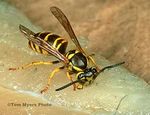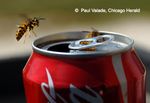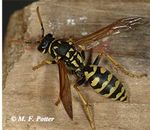Controlling Wasps, Hornets and Yellowjackets - Entomology
←
→
Page content transcription
If your browser does not render page correctly, please read the page content below
Controlling Wasps, Hornets and Yellowjackets Entfact-620
By Michael F. Potter, Extension Entomologist, University of Kentucky
Wasp and hornet stings are a serious threat to pub- or in attics, barns or sheds. Outdoor nests also may
lic health. Allergic reactions to these venomous be constructed behind shutters, or inside porch
insects account for about 225,000 emergency lights, barbeque grills, and mailboxes. Most paper
room visits and as many as 100 deaths per year in wasps are brownish or rust-colored, although one
the U.S. (a mortality rate that may be underre- variety, the European paper wasp, has yellow and
ported due to deaths mistakenly attributed to heart black markings much like a yellowjacket. Paper
attacks or other causes) (Wilderness & Environ- wasps have a ‘waist’ that is very thin, however,
mental Medicine, vol. 29 [1] 2018). Paper wasps, which distinguishes them from hornets and yel-
hornets and yellowjackets are more dangerous and lowjackets.
unpredictable than honeybees. When these insects
are foraging for resources they are seldom aggres-
sive. But when the nest is threatened the colony
may launch a coordinated assault on the perceived
threat. The attack is facilitated by the release of
alarm pheromones, which attract other colony de-
fenders to the intruder.
Fig. 1: Stinging insects can cause serious harm to the public.
Elimination of wasp and hornet nests should be
performed with great care. ‘Folk’ remedies such
as dousing nests with gasoline or a garden hose
are seldom successful and can result in multiple
Fig. 2: While most paper wasps are brown or reddish (above), the Eu-
stings. ropean paper wasp, Polistes dominula, (below), has markings similar
to yellowjackets.
Paper Wasps -- Paper wasps (as well as hornets
and yellowjackets) construct nests of a paper-like Paper wasps are not very aggressive, but stings
material containing finely-chewed wood frag- can occur when householders inadvertently dis-
ments and salivary secretions. They typically turb nests that are hidden. If the nest is accessible,
build their umbrella-shaped nests in protected lo- it can be eliminated fairly easily with a wasp and
cations, such as under eaves, gutters and ledges, hornet spray sold at most retail stores. One ad-
vantage of these formulations is that they can besprayed as far as 20 feet. Although it’s best to treat
all wasp and hornet nests at night, paper wasps can
be eliminated during the daytime, provided you do
not stand directly under the nest during treatment.
Most aerosol-based wasp and hornet sprays cause
insects to drop instantly; standing directly under a
nest increases the risk of being stung. After treat-
ment, wait a few days to ensure that the colony is
destroyed, then scrape or knock down the nest.
Fig. 4: Bald-faced hornets construct large aerial nests (above).
The wasps are larger than yellowjackets and white and black in color
(below).
Fig. 3: Wasp and hornet sprays are useful when treating nests from a
distance.
Householders bent on exterminating a hornet nest
themselves should do so at night, when most of
Hornets -- Hornets are far more difficult and dan- the insects are in the nest and less active (see night
gerous to control than paper wasps. One common treatment precautions mentioned below for yel-
variety, the bald-faced hornet (Dolichovespula lowjackets). A full wasp suit and head veil sealed
maculate), constructs a large, gray nest resem- at the wrists, ankles and collar is strongly recom-
bling a bloated football, which is typically at- mended. Hornet nests usually have a single open-
tached to a tree, bush or side of a building. Often- ing (typically toward the bottom), where the
times the nest is concealed among branches, espe- wasps enter and exit. Apply an aerosol wasp and
cially in densely canopied trees such as Bradford hornet spray or insecticide dust (e.g., Tempo Dust
pear. Hornet nests may contain hundreds of wasps (cyfluthrin), Delta Dust (deltamethrin) directly
that are extremely aggressive when disturbed. into the nest opening. The easiest way to apply in-
Nests are often located out of reach, requiring use secticide products formulated as dusts is with a
of a ladder and/or other specialized equipment. If ‘bulb’ or ‘bellows’ duster sold in hardware stores
elimination is deemed necessary, it is often best to or online. Professionals often use dusters con-
call a professional pest control firm. nected to long extension poles so they can access
and treat nests from a greater (and safer) distance.
It is crucial that the paper envelope of the nest not
be broken during treatment or the irritated wasps
will scatter in all directions, causing even greater
problems. Following treatment, wait at least 3-4
days before removing the nest to ensure that all of
2the wasps are killed. If hornets continue to be
seen, the treatment may need to be repeated.
Fig. 5 and 6: Protective clothing is advisable when treating wasp and
hornet nests (left). Professionals sometimes use long-handled dusters
to treat nests in elevated locations (right).
If the nest is located away from frequently used
areas, another option is to wait and do nothing. In
Kentucky and other states with cold winters,
wasp, hornet and yellowjacket colonies die off
naturally once the weather turns cold and the pa-
per carton disintegrates over the winter months.
Fig. 7: Yellowjackets are one of the most dangerous insect pests in the
U.S. Although nests are often constructed belowground, this one was
Yellowjackets -- Yellowjackets are arguably the located in an attic.
most dangerous stinging insects in the United
States. They tend to be unpredictable and usually If the yellowjacket nest can be located, it often can
sting if the nest is disturbed. Nests are often con- be eliminated by applying an aerosol-type wasp
structed belowground in old chipmunk/rodent and hornet spray into the opening. Insecticide
burrows, or beneath rocks, gutter splash blocks, or dust formulations (as mentioned previously for
landscape timbers. They also nest in stone walls, hornets) are especially effective but require a
crawlspaces, attics, and behind exterior siding of ‘bulb’ or ‘bellows’ duster to dispense several
buildings. puffs of the dust into the nest opening. In lieu of a
commercial duster, an alternative is to use a dry,
empty liquid detergent bottle filled with a few
inches of the dust. A couple pebbles or marbles
added to the bottom prevents the dust from caking,
and the bottle should be shaken before dispensing.
Remember to dispose of the bottle after use, or
store it away from children and pets. Dusts tend to
be more effective than aerosols when the nest it-
self is located some distance from where the
wasps are entering and existing — as often occurs
3when yellowjackets build nests in rock walls, be- With insect prey becoming scarce, yellowjackets
hind exterior siding, or deep within abandoned an- scavenge widely for other sources of nutrition.
imal burrows. Insecticide dust blown into the They’re particularly fond of sweets (fruit, soft
opening penetrates farther than sprays, and is drinks, ice cream, etc.) but will also feed on meat,
transported more thoroughly throughout the col- fish, and just about anything else we eat.
ony.
Fig. 9: Yellowjackets become more apparent in late-summer, when
they are attracted to picnic items.
Fig. 8: Insecticide dusts are most effectively applied with a bellows-
type duster. The persistent foraging of yellowjackets this time
of year at picnics and other outdoor activities
As with hornets, treatment should be performed at
prompts many calls from people wanting to know
night when most of the yellowjackets are in the
what can be done to alleviate the problem. Options
nest and less active. Pinpoint the nest opening
include:
during the daytime, so you will remember where
to direct treatment after dark. Approach the nest 1. Sanitation – The best way to reduce the threat
slowly, and do not shine the flashlight beam di- of foraging yellowjackets is to minimize attractive
rectly into the nest entrance as this may startle the food sources. People eating outdoors should keep
wasps and cause them to fly toward the light. In- food and beverages covered until ready to be
stead, cast the shaft of light to the side to illumi- eaten. Spills and leftovers should be cleaned up
nate the nest opening indirectly. If possible, place promptly. Trash cans should be equipped with
the light source on the ground rather than in your tight-fitting, preferably self-closing lids. Similar
hand. sanitation measures should be taken by outdoor
cafes, produce stands, and other food establish-
When contemplating extermination of a yellow-
ments. Whenever possible, trash cans and dump-
jacket nest, householders should realize they are
sters should be located away from serving tables,
entering a ‘DANGER ZONE’ — there is no pest
doors, and other high-traffic areas. Trash cans
control scenario more frightening than a ‘botched’
should also be equipped with a plastic liner, and
treatment. It is usually prudent to call a profes-
emptied and cleaned frequently.
sional, especially when accessing nests requires
use of a ladder, or is otherwise difficult. When
treating nests located behind the exterior siding of
a home, do not seal the spot where the wasps are
entering and exiting, as this may cause them to
chew their way inward and emerge indoors.
Nuisance Foraging in Late Summer. During
late summer/early fall, yellowjacket colonies are
nearing maturity and huge numbers of workers are
out foraging for food for the developing queens. Fig. 10: Outdoor waste receptacles are very attractive to late-season
yellowjackets.
4Maintaining high levels of sanitation early in the Avoid scented soaps, shampoos, deodorants, per-
summer will help make areas less attractive to yel- fume, or cologne since these tend to attract forag-
lowjackets later in the year. This approach is es- ing yellowjackets.
pecially useful for parks and other outdoor recre-
4. Traps – Yellowjacket traps of varying design
ation sites. Apples, peaches, and other fallen fruits
are sold by lawn and garden suppliers. Properly
should be raked up and discarded.
baited and maintained, these traps often attract
2. Avoidance – Another guideline for late-season and capture large numbers of foraging yellow-
yellowjackets is avoidance. Workers foraging jackets. Unfortunately, late-season nests often
away from nests are seldom aggressive and usu- contain thousands of individuals and such trap-
ally will not sting unless provoked. People should ping seldom results in a noticeable decline in ac-
resist the temptation to swat at the wasps, since tivity. If traps are used, position them around the
most stings occur when foragers are slapped or periphery of the area you wish to protect. Other-
trapped against skin. If a wasp or bee enters your wise, you may end up attracting more wasps than
vehicle, stop the car and open all windows to al- are trapped.
low it to escape. Be extremely careful when drink-
ing from beverage cans into which a foraging yel-
lowjacket may have crawled. Swelling resulting
from a wasp sting inside the mouth can be espe-
cially dangerous. Avoidance is also prudent if a
yellowjacket (or hornet) nest is located high up in
a tree, or other out-of-the-way area. Throughout
much of the country, colonies die off in late-au-
tumn with the onset of cold weather; abandoned
nests are not reused and soon disintegrate.
Fig. 12: Yellowjacket traps may capture several wasps, but do not nec-
essarily alleviate the problem.
5. Finding/Destroying Nests – With late-season
foragers, this approach is often impractical since
the nest(s) may be located several hundred yards
away. Nonetheless, it still may be worth checking
yards and nearby areas for signs of nests. The best
time to do this is during the daytime, when wasps
Fig. 11: Consuming beverages can be hazardous when yellowjackets
are actively exiting and entering the nest opening.
are present. (Photo credit: Paul Valade, Chicago Daily Herald) Surveying one’s yard for yellowjacket nests dur-
ing the summer can help prevent a painful encoun-
3. Repellents – Conventional mosquito and tick
ter while mowing or gardening, or by children at
repellents will not prevent persistent foraging by
play.
yellowjackets. While formulations containing
DEET may lessen the tendency of wasps to alight First Aid for Stings - The health impacts from
on bare skin, long-sleeve shirts and pants are prob- insect stings vary widely. Most people experience
ably a better option when hiking or camping. pain, itching, redness, and localized swelling,
5which can be reduced with over-the-counter anti-
histamines and an ice pack. Cleansing the affected
areas with soap and water can also help prevent
infection.
Conversely— about two million people in the
U.S. (roughly one percent of the population) are
hypersensitive to the venom and can have a poten-
tially life-threatening allergic reaction. Signs and
symptoms include hives, widespread itching, dif-
ficulty breathing or swallowing, swelling of the
face, throat, or mouth, dizziness, rapid pulse, and
a drop in blood pressure. Since death can occur in
a matter of minutes, people experiencing such
symptoms should receive medical attention im-
mediately. They should not wait to see if the Fig. 13: People hypersensitive to wasp stings are often advised to
carry epinephrine.
symptoms go away.
Revised: 9/10/2018
Individuals who are hypersensitive to insect stings
are often advised to carry an epinephrine auto-in- CAUTION: Some pesticides mentioned in this publication may
not be legal in your area of the country. If in doubt, please consult
jector (e.g., EpiPen), to be administered immedi- your local cooperative extension service or regulatory agency. Fur-
ately after a sting. After the injection, it is still pru- thermore, ALWAYS READ AND FOLLOW LABEL DIREC-
dent to go to an emergency room to ensure that TIONS FOR THE PRODUCT YOU ARE USING.
symptoms do not recur. People who have experi- Please note that content and photos in this publication are copy-
enced moderate to severe allergy symptoms, or righted material and may not be copied or downloaded without
have been stung repeatedly in the past, should permission of the Department of Entomology, University of Ken-
tucky.
consider being evaluated for hypersensitivity by
an allergist or immunologist — a prudent precau-
tion in case they are stung again in the future.
6You can also read



























































